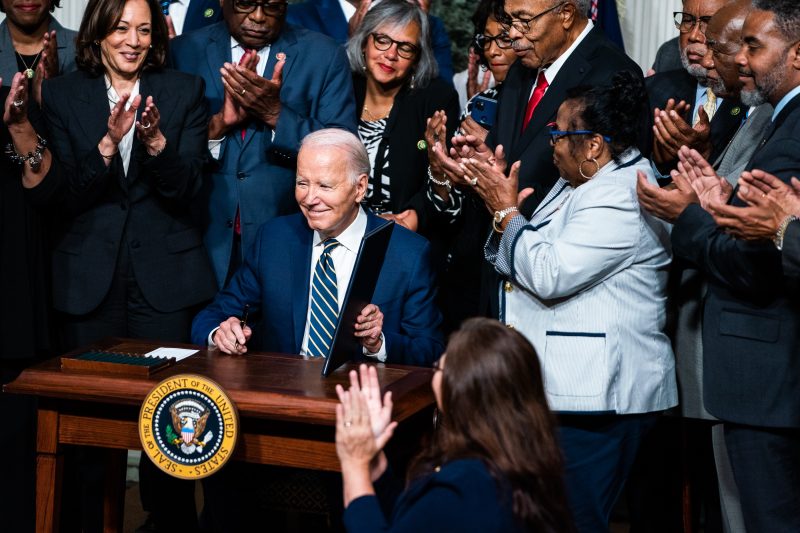President Biden on Tuesday signed a proclamation to establish a new national monument dedicated to Emmett Till, who was brutally murdered at age 14 in 1955, and to his mother, Mamie Till-Mobley, whose activism in the wake of her son’s death helped spark the civil rights movement.
Biden and Vice President Harris, speaking before the signing, used the moment to emphasize the importance of remembering the country’s “full history” amid increasing efforts by some state-level lawmakers to ban books and restrict what can be taught in public schools.
“At a time when there are those who seek to ban books, bury history, we’re making it clear — crystal, crystal clear — while darkness and denialism can hide much, they erase nothing,” Biden said. “We can’t just choose to learn what we want to know. We have to learn what we should know. … We should know everything: the good, the bad, the truth of who we are as a nation. That’s what great nations do.”
The Emmett Till and Mamie Till-Mobley National Monument will encompass two sites in Mississippi and one in Chicago, Biden said Tuesday, on what would have been Till’s 82nd birthday.
The locations selected for the monument are a Tallahatchie River bank in Mississippi, where the Black teenager’s body was found; the Tallahatchie County Courthouse in Sumner, Miss., where those accused of killing him were acquitted by an all-White jury; and the Roberts Temple Church of God in Christ in Chicago, where Till’s funeral was held and his mother allowed the undertakers to show his mutilated corpse.
“Insisting on an open casket for her murdered and, I might add, maimed and mutilated son,” Biden said. “She said, ‘Let the people see what I’ve seen. Let the people see what I have seen.’ My God … it’s hard to fathom. But today, on what would have been Emmett’s 82nd birthday, we add another chapter in the story of remembrance and healing.”
The new national monument is the fourth Biden has announced since taking office. Before signing the proclamation, Biden also paid tribute to the Black news publications that he said were “unflinching” in telling Till’s story, and to Till’s family for “never giving up.”
“The designation reflects the Biden-Harris administration’s work to advance civil rights and commitment to protecting places that help tell a more complete story of our nation’s history,” White House press secretary Karine Jean-Pierre said Monday.
In their remarks Tuesday, Biden and Harris did not call Florida Gov. Ron DeSantis (R) by name but referred to his claims that some Black people benefited from slavery. Just last week, Harris traveled to Florida to slam Republicans’ efforts there to alter the Black history taught in its schools, calling the revised curriculum “propaganda.”
“Today, there are those in our nation who would prefer to erase or even rewrite the ugly parts of our past. Those who attempt to teach that enslaved people benefited from slavery. Those who insult us in an attempt to gaslight us, who try to divide our nation with unnecessary debates,” Harris said Tuesday. “Let us not be seduced into believing that somehow we will be better if we forget. … It is only by understanding and learning from our past that we can continue to work together to build a better future.”
Biden described what happened to Till as “barbaric,” while Harris described it as “an act of astonishing violence.” In August 1955, Mamie Till-Mobley put her only son on a train to Mississippi, warning him that the state was a boiling pot of racism. She reminded Emmett, who had grown up in Chicago, that he should be careful around White people and to obey his uncle.
The Rev. Wheeler Parker Jr., Till’s cousin, says the family was hesitant.
“They did not want Emmett to go,” said Parker, the author of “A Few Days Full of Trouble: Revelations on the Journey to Justice for My Cousin and Best Friend, Emmett Till.” “To understand that, you had to go back to 1955 and the conditions that were in America, and especially in the South.”
On Aug. 24, 1955, Emmett and his cousins decided to buy candy and snacks at Bryant’s Grocery and Meat Market in Money, Miss. Parker says he remembers thinking as Emmett entered the store, “I hope he got his language right.”
As they left, Carolyn Bryant, the store clerk, walked out front. “Emmett loved to make people laugh, and so he whistled,” Parker said.
Parker said he was stunned. “He gave the wolf whistle and we could not believe it,” he said. “If there was any way possible, we would have disappeared. We knew that he had violated the Southern mores. That was not good at all. So we all made a beeline for the car.”
A few nights later, Carolyn Bryant’s husband, Roy Bryant, and his half brother, J.W. Milam, drove to the home of Emmett’s great-uncle, Mose Wright, and demanded that Emmett come out.
The men pulled Emmett from his bed and tussled over Emmett wanting to put on his shoes, Parker said. They marched Emmett out of the house and told his grandfather they “would bring him back if he wasn’t the one,” he recalled. “My grandfather said he heard a light voice, like a woman’s voice, who said, ‘That’s the one.’
“That was the last time we saw him alive.”
Three days later, on Aug. 31, 1955, Emmett’s body was pulled from the Tallahatchie River. He had been brutally tortured, beaten and fatally shot. His skull was crushed, one eye was dislodged, and a cotton-gin fan was tied around his neck with barbed wire.
Till-Mobley, Till’s mother, demanded that his battered and bloated body be returned home to Chicago, where she then opened his casket during his wake and funeral to “let the world see” what hatred and racism had done to her only son.
What happened that night is something everybody needs to know, Parker said. The national monument, he said, will help people understand the racist terror they faced in the South. “The things they were afraid could happen,” he said, “were exactly what happened.”
“This new national monument is the physical evidence and a living testimony to the legacy of one family whose unimaginable tragedy led our nation one step closer to the arc of justice,” said Brent Leggs, executive director of the African American Cultural Heritage Action Fund and senior vice president of the National Trust for Historic Preservation. “We encourage the world to learn from this history, reckon with what caused harm and continue the work to prevent the same trauma from ever happening again.”



























